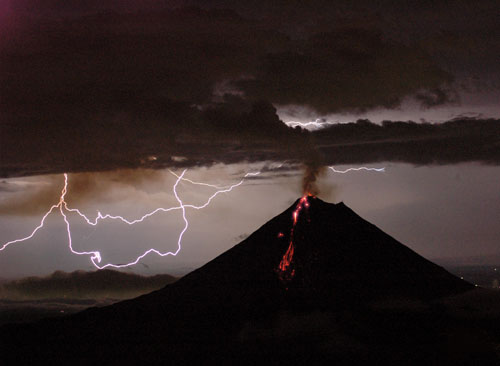When the doors of the earth slam shut
 [Image: Arenal Volcano, Costa Rica].
[Image: Arenal Volcano, Costa Rica]."Imagine if plate tectonics stopped tomorrow," New Scientist suggests. A world without tectonics would be a world without earthquakes, the continents frozen in place, coastlines locked where they are. New mountains could never form, islands would stop emerging from the sea, and apartment insurance would be considerably cheaper.
While the end of tectonics is "not likely to happen any time soon," the article reminds us, "a controversial new theory says it could [come to an end] in about 350 million years." In fact, global tectonic activity may have ceased once before – "around 1.6 to 1.1 billion years ago, as a supercontinent called Rodinia formed." At that point, "all plate tectonics could have ceased for 100 million years." This caused the earth's surface to thicken, forming "a large band of granites" that now "stretches across the northern hemisphere."
But the internal roiling heat and liquid rock of the earth's core and mantle gradually intensified, growing strong enough to punch through the earth's rocky surface; this, kick-starting an era of volcanic eruption strong enough to break the continents apart, "would have got plate tectonics going again."
The belts of the earth were soon turning; new mountains began to rise; island chains drifted, crashing into one another; coasts trembled from below as their guts turned to gravel.
And it all may happen again: according to Paul Silver, of the Carnegie Institution's Department of Terrestrial Magnetism, the doors of the earth may slam shut in 350 million years, locking closed – perhaps initiating another one-hunded million years of terrestrial calm.





Comments are moderated.
If it's not spam, it will appear here shortly!
Has he said anything about the idea that the magnetics of the poles of the Earth, and their movement can affect the movement of the liquid around it? I wonder if it does. If kepler were right(who knows?) isn't there a large tetrahedron in the middle? If this were to be oriented towards a pole, and suddenly this magnetic pole were to be switched (a passing heavy-gravity object, an alignment of planets) wouldn't the rotation of a faceted object stir these magnetic liquids? Thus causing even larger plate movent and thus massive earthquakery?
that tectonic massage-therapy idea of yours is sounding better every day.
Now I know where my socks all went...
In any case, I like the iron catastrophe. Surely the US can build a weapon that could do that all over again? The Earth Weapon.
Well what a small world - I comment on someone's blog (I've 'met' (virtually) via a blog of a blog) and he mentions a New Scientist article by Paul Silver about Rodinia I might be interested in so I google looking for that, which brings me here... and find you have interviewed my friend Jeff Vandermeer.
Anyway, glad I arrived - it's an excellent blog with lots of fascinating stuff. No doubt I shall be back.
The belts of the earth were soon turning; new mountains began to rise; island chains drifted, crashing into one another; coasts trembled from below as their guts turned to gravel.
Today's terrifying look into what might happen tomorrow! What if science miscalculates, and the world totters on the brink of destruction?
THANK GOD it's only a New Scientist article!
Post a Comment